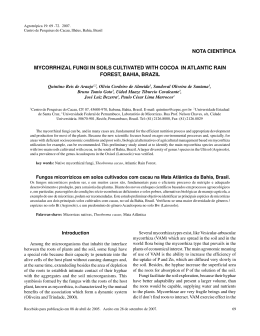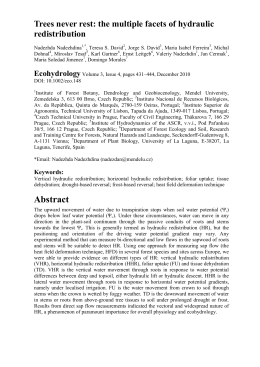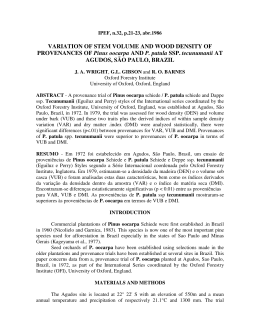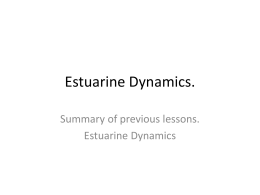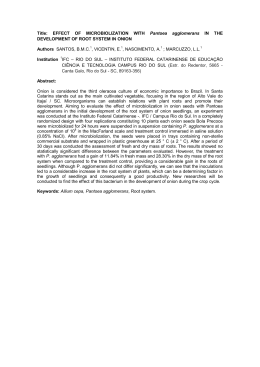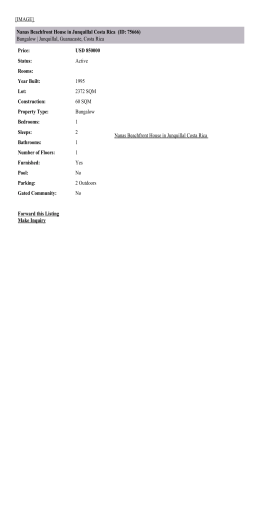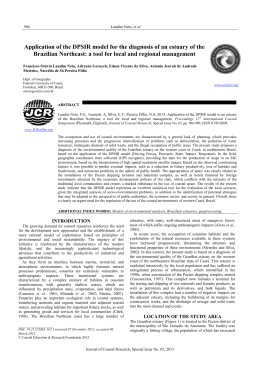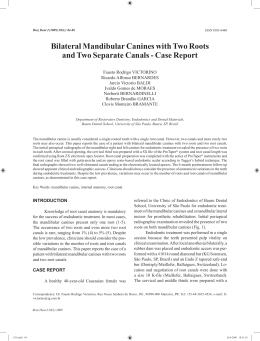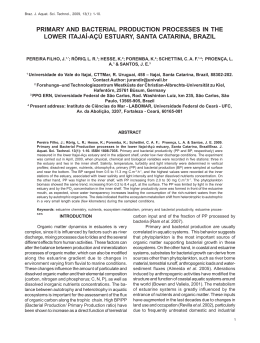Survival and development of Salicornia and Sarcocornia transplant from natural conditions to drip seawater irrigation plots Erika Santos1*, Joana Pacheco1, Aldina Diogo1, Domitília Marques1, Marco Lopes2, Susana Mendes1,2, Miguel Salazar1,2 1Centro de Investigação em Ciências do Ambiente e Empresariais, Instituto Superior D. Afonso III, Loulé - Portugal. [email protected] 2Agro-on – Qualidade e Inovação Agro-Alimentar, Faro - Portugal INTRODUCTION: There are environmental and economic interests in the cultivation of some halophytes. The increase of salinity can lead the inhibition of the growth and, consequently, the reduction of the crops yield of halophytes. Thus, the adaptation of conventional agro-technique to the specific conditions of soils, estuary water, halophytes species and even ecotypes is essential. OBJECTIVE: to evaluate the survival and growth of Salicornia and Sarcoconia transplants from natural conditions to levee and saltmarsh soils irrigated with estuary water. MATERIALS AND METHODS Natural transplants (plants with 8 – 10 cm of height) from Nature Reserve of Saltmarshes from Castro Marim e Vila Real de Santo António (SE of Portugal) Salicornia ramosissima J. Woods, Salicornia patula Duval-Jouvé, Sarcocornia perennis (Miller) A.J. Scott subsp. perennis Mesocosm assay (from May to August) Two trial sites: levee (structures that separate the salt evaporation ponds); secondary saltmarsh (typical saltmarshes which no longer suffer the influence of the tide due to construction of protection dykes along the Guadiana River in the 30’s) Plots (0.30 x 0.90 m): Soil prepared with a harrow drag, with existing mulch incorporation and further manual refinement Irrigation: water from estuary at 28 mm/day with electrical conductivity (EC) C of 54.0 – 84.4 dS/m for levee and 61.3 – 83.3 dS/m for saltmarsh Sampling and analyses: Soil characterisation Plant survival weekly until have no more dead individuals When plants reached 15 cm of height sampling of whole plant Separation roots and shoots analyses of growth (length of the main root, fresh and dry weight of roots and shoot) 30 Roots Fresh weight 25 20 15 10 5 Dry weigth 25 20 15 10 Roots biomass (g/plant) Shoots 2 30 Shoots biomass (g/plant) Length of roots and shoots (cm) Plants from natural conditions (without irrigation) control Fresh weight 1.8 Dry weigth 1.6 1.4 1.2 1 0.8 0.6 0.4 5 0.2 0 Levee Saltmarsh Natural Levee Saltmarsh Natural Salicornia patula Salicornia ramosissima Levee Saltmarsh Levee Saltmarsh Natural Salicornia patula Sarcocornia perennis Figure 1 – Roots and shoots lengths of Salicornia and Sarcocornia species growing in mesocosm experiment (levee and saltmarsh) and natural conditions (mean, n=3) RESULTS 0 0 Levee Saltmarsh Natural Salicornia ramosissima Levee Sarcocornia perennis Figure 2 – Roots biomass (fresh and dry weight) of Salicornia and Sarcocornia species growing in mesocosm experiment (levee and saltmarsh) and natural conditions (mean, n=3) Table 1 – Chemical characterization of soils from levee and saltmarsh before implementation of mesocosm assay Levee Saltmarsh pH in saturated paste extract 8.4 7.5 EC in saturated paste extract (dS/m) 4.62 54.0 Organic matter (g/kg) 21.7 11.5 Total carbonates (g/kg) < 30 < 30 5 1 Extractable K (mg/kg) 565 906 Extractable P (mg/kg) 11 23 Nitric N (mg/kg) 35.6 14.7 K 1.4 9.5 Mg 11.4 134.8 Na 7.6 475.6 Carbonates 1.3 < Dl Chlorides 6.8 549.7 Nitrates < 0.2 < 0.2 Sulfates 52.5 135.9 Levee Saltmarsh Natural Levee Saltmarsh Natural Salicornia patula Salicornia ramosissima Levee Saltmarsh Sarcocornia perennis Figure 3 – Shoots biomass (fresh and dry weight) of Salicornia and Sarcocornia species growing in mesocosm experiment (levee and saltmarsh) and natural conditions (mean, n=3) → The high temperature during the experiment and absence of rainfall in winter (which leached the salts into the Table 2 – Transplantation survival rate (%) of Salicornia and Sarcocornia plants growing in mesocosm experiment (levee and saltmarsh) (mean (1 S.E.), n=3) Species Levee Saltmarsh S. patula 43.2 (7.5) 59.3 (9.3) Total concentration in saturated paste extract (meq/L) Ca Saltmarsh S. ramosissima S. perennis 32.1 (6.9) 28.4 (5.4) 50.6 (6.2) 50.6 (5.4) EC: electrical conductivity; Dl: detection limit soils) can justified the low survival rates for all the species. → Independently of the species, transplantation survival rate was slight higher in the saltmarsh than levee (Table 2). → Due to the soil characteristics (lower EC and higher fertility; Table 1), the transplants of all species showed the highest growth (length of roots and shoots and biomass of roots and shoots; Figures 1 - 3). → The irrigation with estuary water of levee soil promoted the development of shoots and roots from all the species, compared to the natural conditions (Figures 1 and 2). CONCLUSIONS: The development of Salicornia crops in levee soil with transplants → More studies should be done to improve the survival rate irrigated with estuary water can be a efficient solution. and growth of plants, specially in saltmarsh soil. Acknowledgments: This study was co-funded by the project “Cultivo sustentável de halófitas na Reserva Natural do Sapal de Castro Marim e Vila Real de Santo António” from Programa POAlgarve 21. We thank the participation of technical team of ICNF/RNSCMVRSA.
Download
